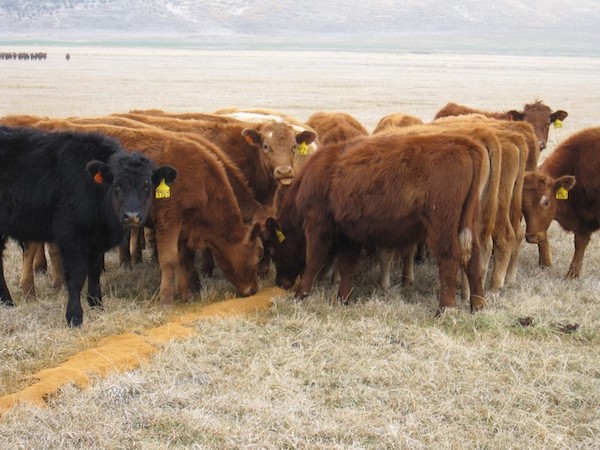Feeding Dried Distillers Grains on the Ground or in a Bunk – How Much Loss Occurs?
September 2016

This article is a summary of the 2012 Nebraska Beef Cattle Report “Comparison of Feeding Dry Distillers Grains in a Bunk or on the Ground to Cattle Grazing Subirrigated Meadow”. Jacqueline A. Musgrave, L. Aaron Stalker, Terry J. Klopfenstein and Jerry D. Volesky were collaborators on this research study and report. The report is summarized by Aaron Berger, Nebraska Extension Beef Educator.
Dried distillers grains are an excellent protein and energy supplement for cattle grazing winter range or meadow. The availability of dried distillers grains (DDGS) and its price in comparison to alternative protein supplements make it a competitive feed option. One question asked when considering the use of dried distillers grains as a protein supplement fed on the ground is how much loss will occur?
Feeding DDGS on the ground will likely result in a higher waste loss than when DDGs is fed in a bunk. However, the flexibility of feeding on the ground may increase its use in grazing situations. This study compared feeding DDGS in a bunk or on the ground at the equivalent of two pounds per head per day, fed three times per week to grazing cattle to estimate difference in loss. The experiment was conducted at the Gudmundsen Sandhills Laboratory near Whitman, Nebraska and took place from March 10 to May 20, 2010. Cattle grazed the same subirrigated meadow pasture throughout the experiment. Steers were weighed at the beginning and end of the study and difference in average daily gain between cattle fed in a bunk versus those fed on the ground was used to estimate loss that occurred.
The 1996 NRC was used to caclulate the DDGS intake difference between the two treatements based on variation in animal performance. The NRC model estimated a reduction of 0.8 – 0.9 pounds per head per day in consumption of DDGS for cattle fed on the ground. This was based on the reduction of 0.27 pounds per head per day in average daily gain. (See Table 2. from the report http://go.unl.edu/3pj6) Based on this estimate, approximatley 40% of DDGS that was fed on the ground was lost as compared to DDGS fed in a bunk.
In this study, feeding DDGS on the ground resulted in more loss than feeding in a bunk. The loss that would occur in other feeding situations could vary depending upon several factors. These factors include, class of cattle fed, amount of feed fed, range or pasture conditions, DDGS fed in piles versus fed in a line, etcetera. The DDGS loss when cattle were fed on the ground in this experiment was signficant and likely due in part to the density and height of the grass on the meadow. However, the cost of feeding more DDGS to compensate for this loss may be less expensive than the cost of feeding in bunks. Feeding on the ground provides management flexibility that is benficial in grazing operations. Feeding DDGS on the ground, even with signficant loss, can be an economical option to feeding DDGS in a bunk.
For producers considering the feeding of modified distillers grains or wet distillers on the ground versus in a bunk there have been two research studies that have been conducted on these feeding methods. Research reported in the the 2014 Nebraska Beef Cattle Report titled “Replacement of Grazed Forage and Animal Performance when Distillers Grains are Fed in a Bunk or on the Ground on Summer Range,” estimated a loss of 5% when modified distillers grains was fed on the ground as compared to feeding in a bunk. A research study on feeding wet distillers grains on the ground versus in a bunk is reported in the 2010 Nebraska Beef Cattle Report titled “Comparison of Feeding Wet Distillers Grains in a Bunk or on the Ground to Cattle Grazing Native Sandhills Winter Range”. In this study, loss from feeding wet distillers grains on the ground was estimated to be approximatley 13 – 20% based on difference in cattle performance when compared with cattle fed in a bunk.
Dr. Aaron Stalker has recorded a short video at the beef.unl.edu website titled “Feeding Distillers Grains on the Ground or in a Bunk - How much waste is there?” that further discusses this topic. For more information on the use of distillers grains as a protien and energy supplement, please visit the http://beef.unl.edu website.
Reference
Aaron Berger, Extension Educator
Panhandle Research & Extension Center
University of Nebraska–Lincoln